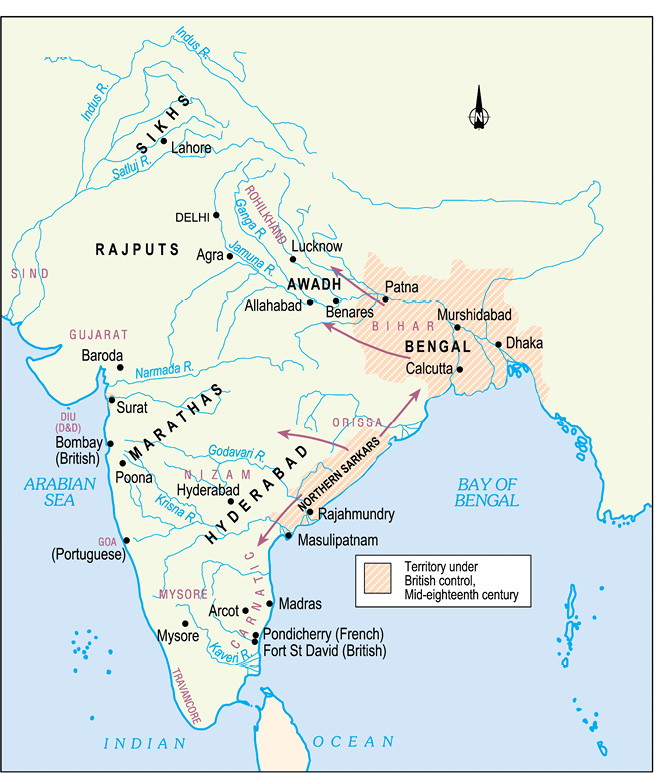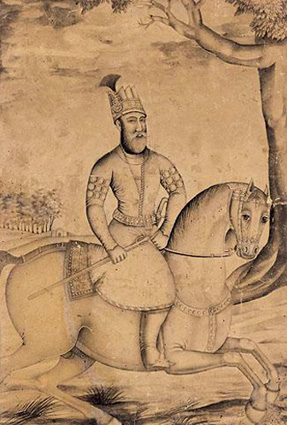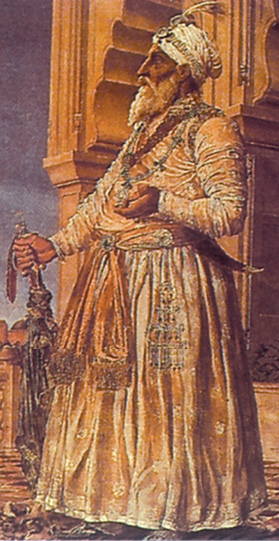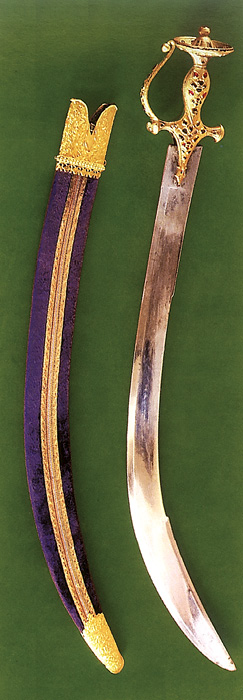Table of Contents
 10
10
EIGHTEENTH-CENTURY POLITICAL FORMATIONS
If you look at Maps 1 and 2 closely, you will see something significant happening in the subcontinent during the first half of the eighteenth century. Notice how the boundaries of the Mughal Empire were reshaped by the emergence of a number of independent kingdoms. By 1765, notice how another power, the British, had successfully grabbed major chunks of territory in eastern India. What these maps tell us is that political conditions in eighteenth-century India changed quite dramatically and within a relatively short span of time.

Map 1 State formations in the eighteenth century.

Map 2 British territories in the mid-eighteenth century.
In this chapter we will read about the emergence of new political groups in the subcontinent during the first half of the eighteenth century – roughly from 1707, when Aurangzeb died, till the third battle of Panipat in 1761.
The Crisis of the Empire and the Later Mughals
In Chapter 4 you saw how the Mughal Empire reached the height of its success and started facing a variety of crises towards the closing years of the seventeenth century. These were caused by a number of factors. Emperor Aurangzeb had depleted the military and financial resources of his empire by fighting a long war in the Deccan.
See Chapter 4, Table 1. Which group of people challenged Mughal authority for the longest time in Aurangzeb’s reign?
Under his successors, the efficiency of the imperial administration broke down. It became increasingly difficult for the later Mughal emperors to keep a check on their powerful mansabdars. Nobles appointed as governors (subadars) often controlled the offices of revenue and military administration (diwani and faujdari) as well. This gave them extraordinary political, economic and military powers over vast regions of the Mughal Empire. As the governors consolidated their control over the provinces, the periodic remission of revenue to the capital declined.
Peasant and zamindari rebellions in many parts of northern and western India added to these problems. These revolts were sometimes caused by the pressures of mounting taxes. At other times they were attempts by powerful chieftains to consolidate their own positions. Mughal authority had been challenged by rebellious groups in the past as well. But these groups were now able to seize the economic resources of the region to consolidate their positions. The Mughal emperors after Aurangzeb were unable to arrest the gradual shifting of political and economic authority into the hands of provincial governors, local chieftains and other groups.
Rich harvests and empty coffers
The following is a contemporary writer’s account of the financial bankruptcy of the empire:
The great lords are helpless and impoverished. Their peasants raise two crops a year, but their lords see nothing of either, and their agents on the spot are virtual prisoners in the peasants’ hands, like a peasant kept in his creditor’s house until he can pay his debt. So complete is the collapse of all order and administration that though the peasant reaps a harvest of gold, his lord does not see so much as a wisp of straw. How then can the lord keep the armed force he should? How can he pay the soldiers who should go before him when he goes out, or the horsemen who should ride behind him?
In the midst of this economic and political crisis, the ruler of Iran, Nadir Shah, sacked and plundered the city of Delhi in 1739 and took away immense amounts of wealth. This invasion was followed by a series of plundering raids by the Afghan ruler Ahmad Shah Abdali, who invaded north India five times between 1748 and 1761.
Nadir Shah attacks Delhi
The devastation of Delhi after Nadir Shah’s invasion was described by contemporary observers. One described the wealth looted from the Mughal treasury as follows:
sixty lakhs of rupees and some thousand gold coins, nearly one crore worth of gold-ware, nearly fifty crores worth of jewels, most of them unrivalled in the world, and the above included the Peacock throne.
Another account described the invasion’s impact upon Delhi:

Fig. 1 A 1779 portrait of Nadir Shah.
(those) … who had been masters were now in dire straits; and those who had been revered couldn’t even (get water to) quench their thirst. The recluses were pulled out of their corners. The wealthy were turned into beggars. Those who once set the style in clothes now went naked; and those who owned property were now homeless … The New City (Shahjahanabad) was turned into rubble. (Nadir Shah) then attacked the Old quarters of the city and destroyed a whole world that existed there …
Already under severe pressure from all sides, the empire was further weakened by competition amongst different groups of nobles. They were divided into two major groups or factions, the Iranis and Turanis (nobles of Turkish descent). For a long time, the later Mughal emperors were puppets in the hands of either one or the other of these two powerful groups. The worst possible humiliation came when two Mughal emperors, Farrukh Siyar (1713-1719) and Alamgir II (1754-1759) were assassinated, and two others Ahmad Shah (1748-1754) and Shah Alam II (1759-1816) were blinded by their nobles.
Emergence of New States
With the decline in the authority of the Mughal emperors, the governors of large provinces, subadars, and the great zamindars consolidated their authority in different parts of the subcontinent. Through the eighteenth century, the Mughal Empire gradually fragmented into a number of independent, regional states. Broadly speaking the states of the eighteenth century can be divided into three overlapping groups: (1) States that were old Mughal provinces like Awadh, Bengal and Hyderabad. Although extremely powerful and quite independent, the rulers of these states did not break their formal ties with the Mughal emperor. (2) States that had enjoyed considerable independence under the Mughals as watan jagirs. These included several Rajput principalities. (3) The last group included states under the control of Marathas, Sikhs and others like the Jats. These were of differing sizes and had seized their independence from the Mughals after a long-drawn armed struggle.

Fig. 2 Farrukh Siyar receiving a noble in court.
The Old Mughal Provinces
Amongst the states that were carved out of the old Mughal provinces in the eighteenth century, three stand out very prominently. These were Awadh, Bengal and Hyderabad. All three states were founded by members of the high Mughal nobility who had been governors of large provinces – Sa‘adat Khan (Awadh), Murshid Quli Khan (Bengal) and Asaf Jah (Hyderabad). All three had occupied high mansabdari positions and enjoyed the trust and confidence of the emperors. Both Asaf Jah and Murshid Quli Khan held a zat rank of 7,000 each, while Sa‘adat Khan’s zat was 6,000.
Hyderabad
Nizam-ul-Mulk Asaf Jah, the founder of Hyderabad state (1724-1748), was one of the most powerful members at the court of the Mughal Emperor Farrukh Siyar. He was entrusted first with the governorship of Awadh, and later given charge of the Deccan. As the Mughal governor of the Deccan provinces, during 1720-22 Asaf Jah had already gained control over its political and financial administration. Taking subsequent advantage of the turmoil in the Deccan and the competition amongst the court nobility, he gathered power in his hands and became the actual ruler of that region.
Asaf Jah brought skilled soldiers and administrators from northern India who welcomed the new opportunities in the south. He appointed mansabdars and granted jagirs. Although he was still a servant of the Mughal emperor, he ruled quite independently without seeking any direction from Delhi or facing any interference. The Mughal emperor merely confirmed the decisions already taken by the Nizam-ul-Mulk Asaf Jah.
The state of Hyderabad was constantly engaged in a struggle against the Marathas to the west and with independent Telugu warrior chiefs (nayakas) of the plateau. The ambitions of the Nizam-ul-Mulk Asaf Jah to control the rich textile-producing areas of the Coromandel coast in the east were checked by the British who were becoming increasingly powerful in that region (see Map 2).
The Nizam’s army
A description of the Nizam of Hyderabad’s personal troopers in 1790:
…The Nizam has a swaree (sawari) of 400 elephants, several thousand of horsemen near his person who receive upwards 100 R(upees)s nominal pay (and) are extremely well mounted and richly caparisoned …
Awadh
Burhan-ul-Mulk Sa‘adat Khan was appointed subadar of Awadh in 1722 and founded a state which was one of the most important to emerge out of the break-up of the Mughal Empire. Awadh was a prosperous region, controlling the rich alluvial Ganga plain and the main trade route between north India and Bengal. Burhan-ul-Mulk also held the combined offices of subadari, diwani and faujdari. In other words, he was responsible for managing the political, financial and military affairs of the province of Awadh.

Fig. 3 Burhan-ul-Mulk Sa‘adat Khan.
Burhan-ul-Mulk tried to decrease Mughal influence in the Awadh region by reducing the number of office holders (jagirdars) appointed by the Mughals. He also reduced the size of jagirs, and appointed his own loyal servants to vacant positions. The accounts of jagirdars were checked to prevent cheating and the revenues of all districts were reassessed by officials appointed by the Nawab’s court. He seized a number of Rajput zamindaris and the agriculturally fertile lands of the Afghans of Rohilkhand.
The state depended on local bankers and mahajans for loans. It sold the right to collect tax to the highest bidders. These “revenue farmers” (ijaradars) agreed to pay the state a fixed sum of money. Local bankers guaranteed the payment of this contracted amount to the state. In turn, the revenue-farmers were given considerable freedom in the assessment and collection of taxes. These developments allowed new social groups, like moneylenders and bankers, to influence the management of the state’s revenue system, something which had not occurred in the past.
In trying to consolidate their rule, why did Mughal subadars also want to control the office of diwan?
Bengal
Bengal gradually broke away from Mughal control under Murshid Quli Khan who was appointed as the naib, deputy to the governor of the province. Although never a formal subadar, Murshid Quli Khan very quickly seized all the power that went with that office. Like the rulers of Hyderabad and Awadh he also commanded the revenue administration of the state. In an effort to reduce Mughal influence in Bengal he transferred all Mughal jagirdars to Orissa and ordered a major reassessment of the revenues of Bengal. Revenue was collected in cash with great strictness from all zamindars. As a result, many zamindars had to borrow money from bankers and moneylenders. Those unable to pay were forced to sell their lands to larger zamindars.
The formation of a regional state in eighteenth- century Bengal therefore led to considerable change amongst the zamindars. The close connection between the state and bankers – noticeable in Hyderabad and Awadh as well – was evident in Bengal under the rule of Alivardi Khan (r. 1740-1756). During his reign the banking house of Jagat Seth became extremely prosperous.

Fig. 4 Alivardi Khan holding court.
If we take a bird’s eye view, we can detect three common features amongst these states. First, though many of the larger states were established by erstwhile Mughal nobles they were highly suspicious of some of the administrative systems that they had inherited, in particular the jagirdari system. Second, their method of tax collection differed. Rather than relying upon the officers of the state, all three regimes contracted with revenue-farmers for the collection of revenue. The practice of ijaradari, thoroughly disapproved of by the Mughals, spread all over India in the eighteenth century. Their impact on the countryside differed considerably. The third common feature in all these regional states was their emerging relationship with rich bankers and merchants. These people lent money to revenue farmers, received land as security and collected taxes from these lands through their own agents. Throughout India the richest merchants and bankers were gaining a stake in the new political order.
The Watan Jagirs of the Rajputs
Many Rajput kings, particularly those belonging to Amber and Jodhpur, had served under the Mughals with distinction. In exchange, they were permitted to enjoy considerable autonomy in their watan jagirs. In the eighteenth century, these rulers now attempted to extend their control over adjacent regions. Ajit Singh, the ruler of Jodhpur, was also involved in the factional politics at the Mughal court.
These influential Rajput families claimed the subadari of the rich provinces of Gujarat and Malwa. Raja Ajit Singh of Jodhpur held the governorship of Gujarat and Sawai Raja Jai Singh of Amber was governor of Malwa. These offices were renewed by Emperor Jahandar Shah in 1713. They also tried to extend their territories by seizing portions of imperial territories neighbouring their watans. Nagaur was conquered and annexed to the house of Jodhpur, while Amber seized large portions of Bundi. Sawai Raja Jai Singh founded his new capital at Jaipur and was given the subadari of Agra in 1722. Maratha campaigns into Rajasthan from the 1740s put severe pressure on these principalities and checked their further expansion.
Many Rajput rulers had accepted the suzerainty of the Mughals but Mewar was the only Rajput state which defied Mughal authority. Rana Pratap ascended the throne at Mewar in 1572, with Udaipur and large part of Mewar under his control. A series of envoys were sent to the Rana to persuade him to accept Mughal suzerainty, but he stood his ground.
Raja Jai Singh of Jaipur
A description of Raja Jai Singh in a Persian account of 1732:
Raja Jai Singh was at the height of his power. He was the governor of Agra for 12 years and of Malwa for 5 or 6 years. He possessed a large army, artillery and great wealth. His sway extended from Delhi to the banks of the Narmada.

Fig. 5 Mehrangarh Fort, Jodhpur

Fig. 4c Jantar Mantar in Jaipur
Sawai Jai Singh, the ruler of Amber constructed five astronomical observatories, one each in Delhi, Jaipur, Ujjain, Mathura and Varanasi. Commonly known as Jantar Mantar, these observatories had various instruments to study heavenly bodies.
Seizing Independence
The Sikhs
The organisation of the Sikhs into a political community during the seventeenth century (see Chapter 8) helped in regional state-building in the Punjab. Several battles were fought by Guru Gobind Singh against the Rajput and Mughal rulers, both before and after the institution of the Khalsa in 1699. After his death in 1708, the Khalsa rose in revolt against the Mughal authority under Banda Bahadur’s leadership, declared their sovereign rule by striking coins in the name of Guru Nanak and Guru Gobind Singh, and established their own administration between the Sutlej and the Jamuna. Banda Bahadur was captured in 1715 and executed in 1716.
What is the Khalsa? Do you recall reading about
it in Chapter 8?
Under a number of able leaders in the eighteenth century, the Sikhs organized themselves into a number of bands called jathas, and later on misls. Their combined forces were known as the grand army (dal khalsa). The entire body used to meet at Amritsar at the time of Baisakhi and Diwali to take collective decisions known as “resolutions of the Guru (gurmatas)”. A system called rakhi was introduced, offering protection to cultivators on the payment of a tax of 20 per cent of the produce.

Fig. 7
Sword of Maharaja Ranjit Singh.

The Sikh territories in the late eighteenth century extended from the Indus to the Jamuna but they were divided under different rulers. One of them, Maharaja Ranjit Singh, reunited these groups and established his capital at Lahore in 1799.
Fig. 7a Portrait of Shivaji

Towards the end of the 17th century a powerful state started emerging in the Deccan under the leadership of Shivaji which finally led to the establishment of the Maratha state. Shivaji was born to Shahji and Jija Bai at Shivneri in 1630. Under the guidance of his mother and his guardian Dada Konddev, Shivaji embarked on a career of conquest at a young age. The occupation of Javli made him the undisputed leader of the Mavala highlands which paved the way for further expansion. His exploits against the forces of Bijapur and the Mughals made him a legendary figure. He often resorted to guerrilla warfare against his opponents. By introducing an efficient administrative system supported by a revenue collection method based on chauth and sardeshmukhi he laid the foundations of a strong Maratha state.
The Marathas
The Maratha kingdom was another powerful regional kingdom to arise out of a sustained opposition to Mughal rule. Shivaji (1627-1680) carved out a stable kingdom with the support of powerful warrior families (deshmukhs). Groups of highly mobile, peasant-pastoralists (kunbis) provided the backbone of the Maratha army. Shivaji used these forces to challenge the Mughals in the peninsula. After Shivaji’s death, effective power in the Maratha state was wielded by a family of Chitpavan Brahmanas who served Shivaji’s successors as Peshwa (or principal minister). Poona became the capital of the Maratha kingdom.

Baji Rao I, also known as Baji Rao Ballal was the son of Peshwa Balaji Vishwanath. He was a great Maratha general who is credited to have expanded the Maratha kingdom beyond the Vindhyas and is known for his military campaigns against Malwa, Bundelkhand, Gujarat and the Portugese.
Between 1720 and 1761, the Maratha empire expanded. It gradually chipped away at the authority of the Mughal Empire. Malwa and Gujarat were seized from the Mughals by the 1720s. By the 1730s, the Maratha king was recognised as the overlord of the entire Deccan peninsula. He possessed the right to levy chauth and sardeshmukhi in the entire region.
After raiding Delhi in 1737 the frontiers of Maratha domination expanded rapidly: into Rajasthan and the Punjab in the north; into Bengal and Orissa in the east; and into Karnataka and the Tamil and Telugu countries in the south (see Map 1). These were not formally included in the Maratha empire, but were made to pay tribute as a way of accepting Maratha sovereignty. Expansion brought enormous resources, but it came at a price. These military campaigns also made other rulers hostile towards the Marathas. As a result, they were not inclined to support the Marathas during the third battle of Panipat in 1761.
Chauth
25 per cent of the land revenue claimed by zamindars. In the Deccan this was collected by the Marathas.
Sardeshmukhi
9-10 per cent of the land revenue paid to the head revenue collector in the Deccan.
Alongside endless military campaigns, the Marathas developed an effective administrative system as well. Once conquest had been completed and Maratha rule was secure, revenue demands were gradually introduced taking local conditions into account. Agriculture was encouraged and trade revived. This allowed Maratha chiefs (sardars) like Sindhia of Gwalior, Gaekwad of Baroda and Bhonsle of Nagpur the resources to raise powerful armies. Maratha campaigns into Malwa in the 1720s did not challenge the growth and prosperity of the cities in the region. Ujjain expanded under Sindhia’s patronage and Indore under Holkar’s. By all accounts these cities were large and prosperous and functioned as important commercial and cultural centres. New trade routes emerged within the areas controlled by the Marathas. The silk produced in the Chanderi region now found a new outlet in Poona, the Maratha capital. Burhanpur which had earlier participated in the trade between Agra and Surat now expanded its hinterland to include Poona and Nagpur in the south and Lucknow and Allahabad in the east.
The Jats
Like the other states the Jats consolidated their power during the late seventeenth and eighteenth-centuries. Under their leader, Churaman, they acquired control over territories situated to the west of the city of Delhi, and by the 1680s they had begun dominating the region between the two imperial cities of Delhi and Agra. For a while they became the virtual custodians of the city of Agra.
The Jats were prosperous agriculturists, and towns like Panipat and Ballabhgarh became important trading centres in the areas dominated by them. Under Suraj Mal the kingdom of Bharatpur emerged as a strong state. When Nadir Shah sacked Delhi in 1739, many of the city’s notables took refuge there. His son Jawahir Shah had 30,000 troops of his own and hired another 20,000 Maratha and 15,000 Sikh troops to fight the Mughals.
The power of the Jats reached its zenith under SurajvMal who consolidated the Jat state at Bharatpur (in present day Rajasthan) during 1756-1763. The areas under the political control of Suraj Mal broadly included parts of modern eastern Rajasthan, southern Haryana, western Uttar Pradesh and Delhi. Suraj Mal built a number of forts and palaces and the famous Lohagarh fort in Bharatpur is regarded as one of the strongest forts built in this region.

Fig. 8 Eighteenth-century palace complex at Dig. Note the “Bangla dome” on the assembly hall on the roof of the building.
While the Bharatpur fort was built in a fairly traditional style, at Dig the Jats built an elaborate garden palace combining styles seen at Amber and Agra. Its buildings were modelled on architectural forms first associated with royalty under Shah Jahan (see Figure 12 in Chapter 5 and Figure 12 in Chapter 9).
ELSEWHERE
The French Revolution (1789-1794)
In the various state systems of eighteenth-century India, the common people did not enjoy the right to participate in the affairs of their governments. In the Western world, this was the situation until the late eighteenth century. The American (1776-1781) and French Revolutions challenged the social and political privileges enjoyed by the aristocrats.
During the French Revolution, the middle classes, peasants and artisans fought against the special rights enjoyed by the clergy and the nobility. They believed that no group in society should have privileges based on birth. Rather, people’s social position must depend on merit. The philosophers of the French Revolution suggested that there be equal laws and opportunities for all. They also held that the authority of the government should come from the people who must possess the right to participate in its affairs. Movements such as the French and American Revolutions gradually transformed subjects into citizens.
 Imagine
ImagineYou are a ruler of an eighteenth-century kingdom. Tell us about the steps you would take to make your position strong in your province, and what opposition or problems you might face while doing so.
Keywords
subadari
dal khalsa
misl
faujdari
ijaradari
chauth
sardeshmukhi
Let’s recall
1. Match the following:
subadar a revenue farmer
faujdar a high noble
ijaradar provincial governor
misl Maratha peasant warriors
chauth a Mughal military commander
kunbis a band of Sikh warriors
umara tax levied by the Marathas
2. Fill in the blanks:
(a) Aurangzeb fought a protracted war in the ____________________.
(b) Umara and jagirdars constituted powerful sections of the Mughal __________________.
(c) Asaf Jah founded the Hyderabad state in _____________________.
(d) The founder of the Awadh state was ______________________.
3. State whether true or false:
(a) Nadir Shah invaded Bengal.
(b) Sawai Raja Jai Singh was the ruler of Indore.
(c) Guru Gobind Singh was the tenth Guru of the Sikhs.
(d) Poona became the capital of the Marathas in the eighteenth century.
4. What were the offices held by Sa‘adat Khan?
Let’s discuss
5. Why did the Nawabs of Awadh and Bengal try to do away with the jagirdari system?
6. How were the Sikhs organised in the eighteenth century?
7. Why did the Marathas want to expand beyond the Deccan?
8. What were the policies adopted by Asaf Jah to strengthen his position?
9. Do you think merchants and bankers today have the kind of influence they had in the eighteenth century?
10. Did any of the kingdoms mentioned in this chapter develop in your state? If so, in what ways do you think life in the state would have been different in the eighteenth century from what it is in the twenty- first century?
Let’s do
11. Find out more about the architecture and culture associated with the new courts of any of the following Awadh, Bengal or Hyderabad.
12. Collect popular tales about-rulers from any one of the following groups of people: the Rajputs, Jats, Sikhs or Marathas.